
Fort Edward is a National Historic Site of Canada in Windsor, Nova Scotia, and was built during Father Le Loutre's War (1749-1755). The British built the fort to help prevent the Acadian Exodus from the region. The Fort is most famous for the role it played both in the Expulsion of the Acadians (1755) and in protecting Halifax, Nova Scotia from a land assault in the American Revolution. While much of Fort Edward has been destroyed, including the officers' quarters and barracks, the blockhouse that remains is the oldest extant in North America. A cairn was later added to the site.
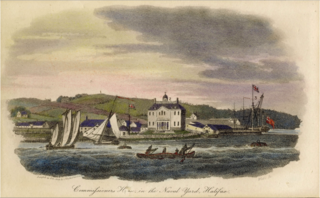
Royal Naval Dockyard, Halifax was a Royal Navy base in Halifax, Nova Scotia. Established in 1759, the Halifax Yard served as the headquarters for the Royal Navy's North American Station for sixty years, starting with the Seven Years' War. The Royal Navy continued to operate the station until it was closed in 1905. The station was sold to Canada in 1907 becoming His Majesty's Canadian Dockyard, a function it still serves today as part of CFB Halifax.

St. Paul's Church is a historically evangelical Anglican church in downtown Halifax, Nova Scotia, within the Diocese of Nova Scotia and Prince Edward Island of the Anglican Church of Canada. It is located at the south end of the Grand Parade, an open square in downtown Halifax with Halifax City Hall at the northern end.

The Old Burying Ground is a historic cemetery in Halifax, Nova Scotia, Canada. It is located at the intersection of Barrington Street and Spring Garden Road in Downtown Halifax.

Jonathan Belcher was a British-American lawyer, chief justice, and acting Governor of Nova Scotia during the period of 1760-63 when Henry Ellis was in office as Governor but did not fulfil his duties.
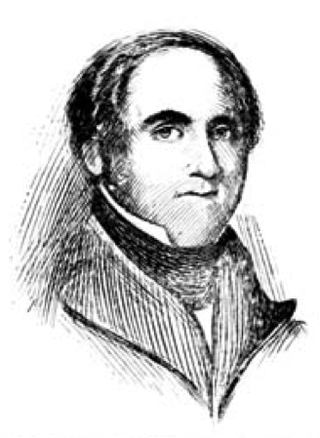
Charles Morris army officer, served on the Nova Scotia Council, Chief Justice of the Nova Scotia Supreme Court (1776–1778) and, the surveyor general for over 32 years, he created some of the first British maps of Canada's maritime region and designed the layout of Halifax, Lunenburg, Lawrencetown, and Liverpool. In Halifax, he laid out both the present-day down town core and the Halifax Common.

Richard Bulkeley was an influential administrator in Nova Scotia from 1749 to 1800. Historian Phyllis Blakeley writes that Bulkeley, "assisted 13 governors and lieutenant governors from Cornwallis to Wentworth. In half a century of service he took part in the founding of Halifax, the immigration of New Englanders and loyalists, and the prosperity of the French revolutionary wars." During his lifetime, known for hosting dignitaries and grand parties, he was known as "the Father of the Province." When he died, he was the last surviving settler who arrived with Cornwallis.
Sebastian Zouberbuhler was a merchant, justice of the peace and politician from Nova Scotia. Born in Switzerland, he emigrated to North America and worked as an agent and merchant, recruiting German Protestants to immigrate to North America. During Britain's occupation of Louisbourg, he traded goods and invested in the settlement. When Louisbourg was returned to France he moved to Halifax to continue his business.
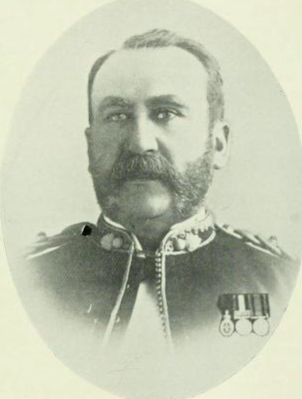
Charles John MacDonald was a lawyer and political figure in Nova Scotia, Canada. He represented Halifax County in the Nova Scotia House of Assembly from 1878 to 1879 as a Liberal-Conservative member. He was a member of the North British Society.
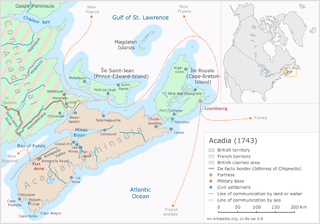
Father Le Loutre's War (1749–1755), also known as the Indian War, the Mi'kmaq War and the Anglo-Mi'kmaq War, took place between King George's War and the French and Indian War in Acadia and Nova Scotia.c On one side of the conflict, the British and New England colonists were led by British officer Charles Lawrence and New England Ranger John Gorham. On the other side, Father Jean-Louis Le Loutre led the Mi'kmaq and the Acadia militia in guerrilla warfare against settlers and British forces. At the outbreak of the war there were an estimated 2500 Mi'kmaq and 12,000 Acadians in the region.

Nova Scotia is a Canadian province located in Canada's Maritimes. The region was initially occupied by Mi'kmaq. The colonial history of Nova Scotia includes the present-day Maritime Provinces and the northern part of Maine, all of which were at one time part of Nova Scotia. In 1763, Cape Breton Island and St. John's Island became part of Nova Scotia. In 1769, St. John's Island became a separate colony. Nova Scotia included present-day New Brunswick until that province was established in 1784. During the first 150 years of European settlement, the colony was primarily made up of Catholic Acadians, Maliseet, and Mi'kmaq. During the last 75 years of this time period, there were six colonial wars that took place in Nova Scotia. After agreeing to several peace treaties, the long period of warfare ended with the Halifax Treaties (1761) and two years later, when the British defeated the French in North America (1763). During those wars, the Acadians, Mi'kmaq and Maliseet from the region fought to protect the border of Acadia from New England. They fought the war on two fronts: the southern border of Acadia, which New France defined as the Kennebec River in southern Maine, and in Nova Scotia, which involved preventing New Englanders from taking the capital of Acadia, Port Royal and establishing themselves at Canso.
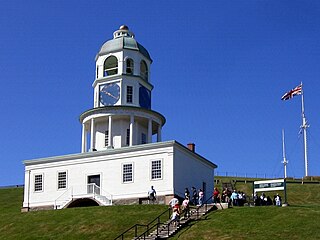
The Burying the Hatchet ceremony happened in Nova Scotia on June 25, 1761 and was one of many such ceremonies in which the Halifax Treaties were signed. The treaties ended a protracted period of warfare which had lasted more than 75 years and encompassed six wars between the Mi'kmaq people and the British. The Burying the Hatchet ceremonies and the treaties that they commemorated created an enduring peace and a commitment to obey the rule of law.
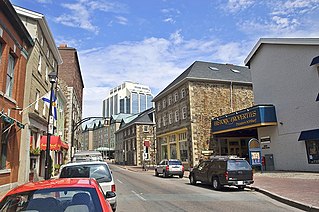
The Historic Properties are warehouses on the Halifax Boardwalk in Halifax, Nova Scotia that began to be constructed during the Napoleonic Wars by Nova Scotian businessmen such as Enos Collins, a privateer, smuggler and shipper whose vessels defied Napoleon's blockade to bring American supplies to the British commander Duke of Wellington. These properties helped make Halifax prosperous in Canada's early days by aiding trade and commerce, but they were also frequently used as vehicles for smuggling and privateering. During the War of 1812, two of the most successful Nova Scotian privateer ships during this time period were the Liverpool Packet and the Sir John Sherbrooke.

The North British Society was founded in Halifax, Nova Scotia in 1768, the oldest Scottish heritage society outside Great Britain. North British is an adjective used as an alternative to "Scottish".

Formally known as "His Majesty's Council of Nova Scotia", the Nova Scotia Council (1720–1838) was the original British administrative, legislative and judicial body in Nova Scotia. The Nova Scotia Council was also known as the Annapolis Council and the Halifax Council. After 1749, when the judicial courts were established, the Nova Scotia Council was limited to administrative and legislative powers.

Fort Ellis was a British fort or blockhouse built during the French and Indian War, located at the junction of the Shubenacadie and Stewiacke Rivers, close to Stewiacke, Nova Scotia, Canada. The location was labelled Ville Pierre Hebert by Charles Morris. The 14 Acadian families in the area vacated with the Acadian Exodus. Charles Morris recommended a Fort on the Shubenacadie River in 1753. Governor Lawrence first considered the fort in 1754 as a means to protect Halifax from Mi'kmaq raids. Lawrence decided the fort would not be effective until after the Battle of Fort Beauséjour. The fort was completed on October 18, 1761, shortly after the Halifax Treaties were signed. The fort was to guard the new road built to connect Truro and Halifax against Mi'kmaq raids. The fort was called Fort Ellis after Governor Henry Ellis, who was appointed governor weeks after the forts completion. The fort was never garrisoned and eventually abandoned in 1767. Fort Belcher, named after Governor Jonathan Belcher, was built on Salmon River in Lower Onslow, Nova Scotia (1761–67). Fort Franklin was built at Tatamagouche in 1768, named after Michael Francklin and lasted only a year. Fort Morris was named after Charles Morris.

The Carleton is a building on Argyle Street in Halifax, Nova Scotia, built in 1760 as the home of Richard Bulkeley. Apart from two churches, Bulkeley's home is the oldest building in Halifax, Nova Scotia (1760). It was reported to have been made from the ruins of Fortress Louisbourg. Since 1786 his residence has been known as "The Carleton".

Duncan Clark (1759-1808) was a Loyalist who became an influential figure in Halifax, Nova Scotia. Duncan Clarke, first and one of the longest serving head of Royal Naval Hospital Halifax (1795-1803). He served in the 82nd Regiment of Foot and arrived in Halifax in 1778. He was a member of the North British Society, eventually becoming president. He was a frequent patron of the Great Pontack (Halifax). Clark also was the head of a Masonic Lodge for Saint John, New Brunswick and later in Nova Scotia. He was also a friend of John Halliburton (surgeon) of the doctor for Prince Edward, Duke of Kent and Strathearn.
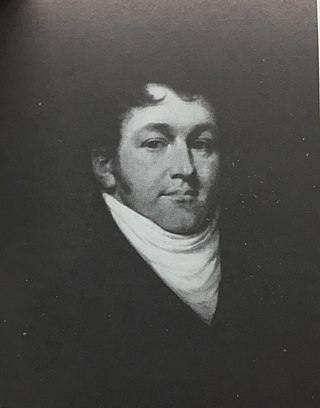
William Bowie (1762-1819) was a prominent merchant of Halifax, Nova Scotia who was killed in the last fatal duel on record in Nova Scotia. At age 20, William Bowie arrived in Nova Scotia in 1782 from Stirling, Scotland, the son of Alexander Bowie and Janet Murdoch. He became president of the North British Society. Under the mentorship of Alexander Brymer, Bowie founded the firm Bowie & DeBlois and in a few years amassed a fortune and Bowie became a leading citizen in Halifax.



























